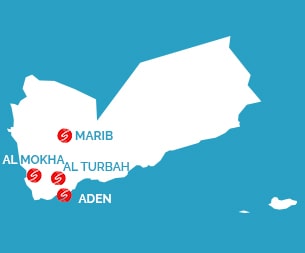Conflict in Yemen started in 2014 and has now entered its 5th year. Operating since 2017 in the South of the country, SOLIDARITÉS INTERNATIONAL’s teams work in two governorates: Taizz and Al Hudeyda. They both are amongst the governorates most affected by armed clashes and ‘’where more than 80% of the population has humanitarian needs’’, explains Thomas Janny, Middle-East desk manager.
How is the situation in Yemen ?
The humanitarian situation in Yemen remains catastrophic. We are talking about the largest humanitarian crisis in the world today, due to conflict. 80% of the population has established humanitarian needs. More than 15 million, meaning 50% of the population, have acute humanitarian needs in terms of accessing health services, water, education and especially food, since this is the biggest current food security crisis worldwide.
What are the biggest difficulties for an NGO working in the midst of conflict?
SOLIDARITÉS INTERNATIONAL works tremendously on access topics: accessing vulnerable populations, accessing populations that are most difficult to reach … This access can be impeded by administrative constraints such as obtaining visas or travel authorizations for example. Access might also be restricted due to security constraints, or risks of armed clashes or attacks.
Logistical issues are also and often challenging for humanitarian workers. But this matter is more or less in our DNA as an NGO, so we try to analyze constraints in a practical manner to find solutions and ensure aid is sent to the people who need it the most.

Yemen
Context and action- 32.98 million inhabitants
- 183rd out of 191 countries on the Human Development Index
- 341.280 people helped
How can you maintain a presence in the field despite armed clashes?
We are still present in the field! However, we assess the risks. Whenever there are fights taking place -this happened recently in Aden for example-, that might potentially affect our teams, we might decide to restrict our movements. This could last for a few hours to many days until things cool down and, especially, until we’re able to ensure our remaining teams’ safety, which is our key priority even if we’re aid workers. As an example, on the Yemeni West coast, where we were for a long time amongst the only present actors delivering drinkable water to the most vulnerable populations, our decision whether we’re able to go to the field and conduct activities is made on a day-to-day basis.
Is your ability to remain closest to combat victims due to your neutrality?
War in Yemen is complex. This is a war opposing two camps at, in my opinion, national level, with both being supported at regional level and with global interests at stake. So, we’re doing our best to discuss with all present parties while maintaining neutrality, which guarantees our access and also our safety, and while insisting that our positioning is neutral of course, but also that our help is impartial. We target the most vulnerable.
SUPPORT OUR ACTION IN YEMEN
Photos : Thomas Gruel / SOLIDARITES INTERNATIONAL

